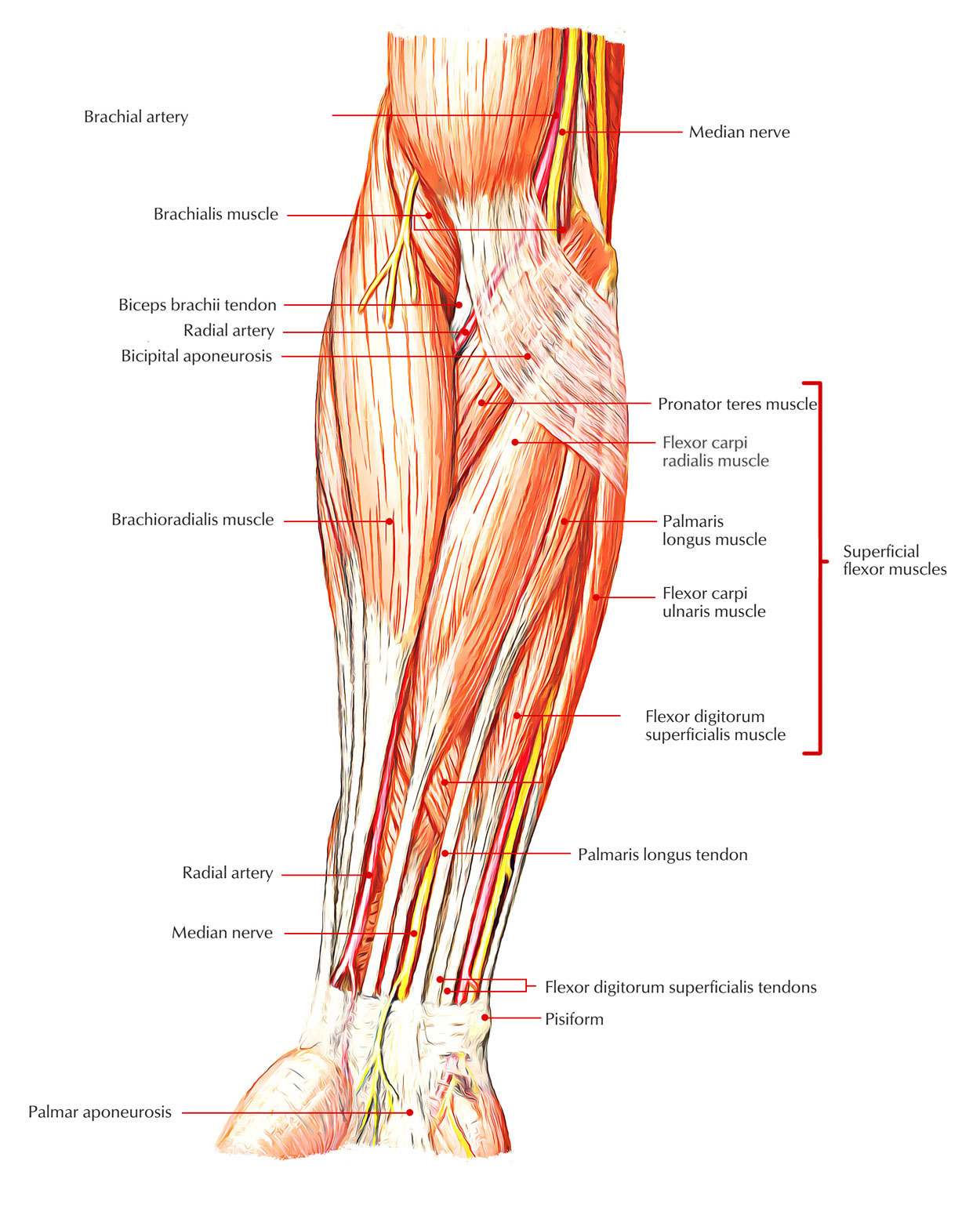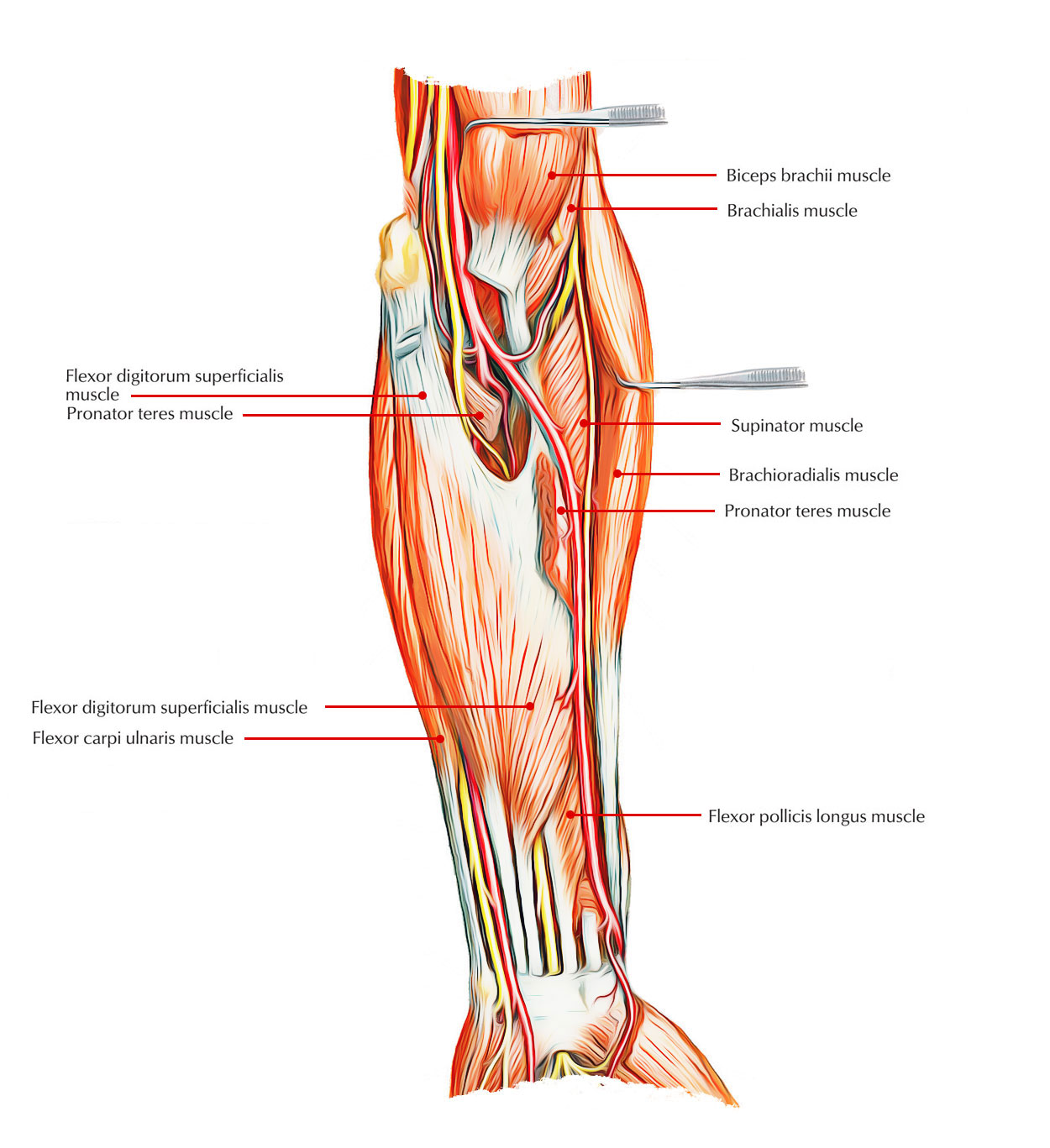The muscles of the anterior of the forearm are generally divided into two groups:
- Superficial
- Deep
Superficial Muscles of The Front of The Forearm
This group consists of five muscles. From lateral to medial side, these are:
- Pronator teres.
- Flexor carpi radialis.
- Palmaris longus.
- Flexor digitorum superficialis.
- Flexor carpi ulnaris.
All these muscles are flexor of the forearm and have a mutual origin– from the front of the medial epicondyle of the humerus called common flexor origin.

Superficial Anterior Muscles of Forearm
Pronator Teres
Pronator teres is smallest and most lateral of the shallow flexors of the forearm. It forms the medial boundary of the cubital fossa.
Origin
It emerges by two heads (a) superficial (humeral) head from the medial epicondyle of the humerus, and (b) deep (ulnar) head from the medial margin of the coronoid method of the ulna.
Insertion
Into the harsh impression on the middle one-third of the lateral surface (most convex part) of the radius.
Nerve Supply
By the median nerve.
Actions
It is the main pronator of the forearm. It also assists in the flexion of elbow.
Clinical Testing
The pronator teres is tested by asking the patient to pronate the forearm from supine position against opposition with elbow flexed.
- Median nerve go on between the two heads of pronator teres.
- Ulnar artery go on deep to the deep head of pronator teres, thus ulnar artery is divided from the median nerve by the deep head of pronator teres in the region of cubital fossa.
Flexor Carpi Radialis
Origin
From the medial epicondyle of humerus by a mutual flexor origin.
Insertion
On to the anterior aspects of the bases of second and third metacarp als.
Nerve Supply
By the median nerve.
Actions
- Acting with flexor carpi ulnaris, it stretches the wrist.
- Acting with brachioradialis, it abducts the wrist.
- The tendon of flexor carpi radialis (FCR) is a good guide to the radial artery, which is located just lateral to it at the wrist.
Palmaris Longus
Origin
From the medial epicondyle of humerus by a common flexor origin.
Insertion
Its long cord-like tendon crosses superficial to the flexor retinaculum and connects to its distal part and joins the apex of palmar aponeurosis.
Nerve Supply
By the median nerve.
Actions
It flexes the wrist and causes the palmar aponeuroses strained.
Morphologically, palmaris longus is a deteriorating muscle with small short belly and a long tendon. The palmar aponeurosis expresses the distal part of the tendon of palmaris longus. The palmaris longus corresponds to the plantaris muscle on the back of the leg.
It is missing on one or both sides (usually on the left) in approximately 10% of people, but its actions are not overlooked. Hence, its tendon is often used by the surgeons for tendon grafting.
Flexor Carpi Ulnaris
The flexor carpi ulnaris (FCU) is most medial of the shallow flexors of the forearm.
Origin
It emerges by two heads: a small humeral head and a large ulnar head.
- humeral head from the medial epicondyle of the humerus by a common flexor origin, and
- ulnar head from the medial margin of the olecranon method and by an aponeurosis from the upper two-third of the posterior border of the ulna.
Insertion
Into (a) pisiform bone and (b) hook of hamate and the base of fifth metacarpal bone (through pisohamate and pisometacarpal ligaments, respectively). The latter is the correct insertion because a sesamoid bone (pisiform) develops in its tendon.
Nerve Supply
By the ulnar nerve.
Actions
- Operating with the extensor carpi ulnaris, it adducts the wrist joint.
- Operating with the flexor carpi radialis, it flexes the wrist joint.
- The ulnar nerve enters the forearm by passing between the two heads of flexor carpi ulnaris, which are linked to each other by a tendinous arch.
- The tendon of flexor carpi ulnaris is a good guide to ulnar nerve and ulnar artery, which lie on its lateral side at the wrist.
Flexor Digitorum Superficialis
The flexor digitorum superficialis (FDS) is the biggest muscle of the superficial group of muscles on the front of the forearm. Effectively speaking, it develops the intermediate muscle layer between the superficial and deep groups of the forearm muscles.
Origin
It emerges by two heads:
- Humero-ulnar head, from the medial epicondyle of humerus, sublime tubercle on the medial margin of the coronoid process of ulna and medial (ulnar) collateral ligament of the elbow joint,
- Radial head, from the anterior oblique line of the radius, extending from the radial tuberosity to the insertion of pronator teres (upper half of the anterior border of radius).
Insertion
Middle phalanges of medial four fingers. The mode of insertion is as follows. The muscles separates into two layers: superficial and deep. The superficial layer creates two tendons, which are inserted into middle phalanges of middle and ring fingers. The deep layer also creates two tendons, which are inserted into middle phalanges index and little fingers. Before insertion each of the four tendons splits, opposite the proximal phalanx, into medial and lateral slips, which are inserted into the corresponding sides of the middle phalanx.
Nerve Supply
By the median nerve.
Actions
- Flexor digitorum superficialis flexes the proximal interphalangeal (PIP) joints of the medial four digits. Acting more powerfully, it also helps in flexion of the proximal phalanges and wrist joint.
- The median nerve and ulnar artery pass downwards deep to the fibrous arch/tendinous arch connecting the humero-ulnar and radial heads of FDS.
- The four tendons of FDS pass deep to flexor retinaculum confined within a common synovial sheath, the ulnar bursa.
Deep Muscles Of the Front Of the Forearm
There are three deep muscles of the front of the forearm, viz.
- Flexor pollicis longus (placed laterally).
- Flexor digitorum profundus (placed medially).
- Pronator quadratus (placed distally).

Deep Anterior Muscles of Forearm
Flexor Digitorum Profundus
The flexor digitorum profundus (FDP) is the most bulky and powerful muscle on the front of forearm and supplies main gripping power to the hand.
Origin
- From upper three-fourth of the anterior and medial surfaces of the shaft of ulna and nearby medial half of the interosseous membrane.
- By an aponeurosis from upper three-fourth of the posterior border of ulna along with flexor and extensor carpi ulnaris muscles.
- From the medial side of olecranon and coronoid process of ulna.
Insertion
On to the palmar aspect of the bases of distal phalanges of medial four digits. The actual mode of injection is as follows: the muscle forms four tendons, which enter the palm by passing deep to the flexor retinaculum. Opposite the proximal phalanx of corresponding digit, the tendon perforates the tendon of flexor digitorum superficialis and passes forward to be inserted in palmar surface of the distal phalanx.
Nerve Supply
- Medial half by the ulnar nerve.
- Lateral half by the anterior interosseous nerve – a branch of the median nerve.
Actions
FDP flexes the distal interphalangeal (DIP) joints of medial four digits. It also helps to flex the wrist joint.
Flexor digitorum profundus-
- is most powerful and large muscle of the forearm,
- has double innervation by median and ulnar nerves,
- offers most of the gripping power to hand,
- forms four tendons which go into the hand by passing deep to flexor retinaculum, posterior to the tendons of FDS in a common synovial sheath– ulnar bursa,
- forms most of the surface elevation medial to the palpable posterior border of the ulna, and
- supplies origin to the lumbrical muscles in the palm.
Clinical Testing
The flexor digitorum profundus is examined by asking the patient to flex the DIP joint, while holding the PIP joint in extension.
The integrity of the median nerve in forearm is examined in this way by using index finger and that of ulnar nerve by using little finger.
Flexor Pollicis Longus
The flexor pollicis longus lies lateral to the FDP and clothes the anterior aspect of the radius distal to the connection of supinator muscle.
Origin
From upper two-third of the anterior surface of the radius below the anterior oblique line and adjoining part of the interosseous membrane.
Insertion
Into the anterior surface of the base of distal phalanx of the thumb.
Actions
- It primarily flexes the distal phalanx of the thumb but secondarily it also flexes proximal phalanx and first metacarpal at the metacarpophalangeal (MP) and carpometacarpal (CM) joints respectively.
- The anterior interosseous nerve and vessels fall on interosseous membrane between flexor pollicis longus and flexor digitorum profundus.
- The flexor pollicis longus is the only muscle, which flexes the interphalangeal joints of the thumb.
Clinical Testing
The flexor pollicis longus is tested by inquiring the patient to flex the interphalangeal joint of the thumb, while proximal phalanx of the thumb is kept in extension.
Pronator Quadratus
It is a flat quadrilateral muscle, which extends across the front of the distal parts of the radius and ulna.
Origin
From an oblique ridge on the lower one-fourth of the anterior surface of the shaft of ulna and medial part of this surface.
Insertion
- The superficial fibres into the distal one-fourth of the anterior border and anterior surface of the shaft of radius.
- The deeper fibres into the triangular area above the ulnar notch of the radius.
Nerve Supply
By anterior interosseous nerve.
Actions
Pronator quadratus is the primary pronator of the forearm and is supported by pronator teres only in quick and forceful pronation.

 (46 votes, average: 4.78 out of 5)
(46 votes, average: 4.78 out of 5)